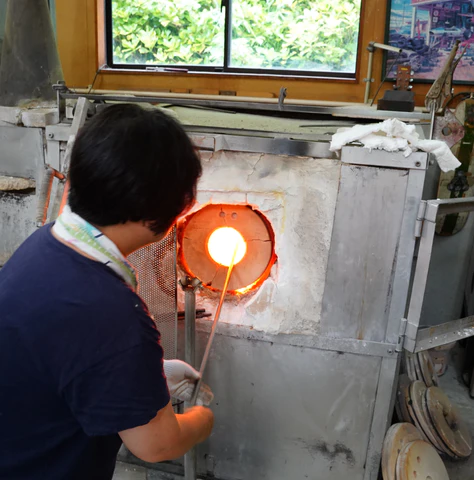Enoden Gokurakuji Station has a nice Showa retro feeling. Gokurakuji Garasu Kobo is located in a small valley nearby.

A beautiful place where Kamakura's nature is rich and where you can feel the constant roar of the wind from the sea. “There are three wild owls around here,” said the owner, Mr. Shoichiro.
Gokurakuji Glass Studio was established in 2004 by Shoichiro and Mutsuko Iwasawa , a couple from Kamakura. The two, who were classmates in junior high school, are both glass artists and create works with a memorable style.

Mrs. Mutsuko, the wife of Mr. Mutsuko, has loved to do hard work such as drawing since she was a child. When I wanted to learn some kind of craft, I happened to come across a piece by an Australian blown glass artist, which shocked me and led me to study at the Tokyo Glass Art Institute. After graduating, he will be a student at the Notojima Glass Studio in order to acquire blown glass production techniques. After completing the course, I persevered and joined the company after being refused many times because I really wanted to work. I will continue to gain experience in Notojima.
Around that time, Shoichiro was wondering whether to continue his beloved scuba diving work related to "water", so he went to Noto Island where Mutsuko was there as a distraction. Seeing everyone working hard to make glass, he thought, "That sounds interesting. I can do it myself," so he secretly sneaked into the studio at night.

Blown glass is made by heating the glass in a kiln at approximately 1,200 degrees Celsius, turning it into a thick liquid, and winding it around a metal tube called a blowing rod. To go. If the rotation of the pole is stopped even a little, the heated glass will fall, but Shoichiro seems to have caught the falling glass with his hand so as not to drop it! ?
“At the time, I guess I thought I could do anything. When the glass came out of the kiln, it was about to fall down. I think the people around Osorak were even more surprised...
In the end, because of the serious burns, I ended up staying in Notojima for nearly a month instead of staying for just a few days. While watching students and staff making glass with swollen and painful hands, I became obsessed with the charm of glass, which is close to my favorite "water". And above all, you will be able to touch the passion of the people you met there and pass through the gates of the Notojima Glass Studio.
After that, after gaining experience for about 10 years each on Noto Island, they returned to their hometown of Kamakura and got married. Construction kiln at the same time.
I was surprised to learn that the two of you started the workshop from the very beginning, starting with the making of the kiln.
"It took about seven months from the drawing up of the blueprints. I had no experience with welding, so the people at the welding company were worried and came to see it. Everyone was really helpful." Mr. Iwasawa. It's a quick thing to say, but these two are amazing!
This is a handmade kiln. A pleasant workshop where the light of a lot of green is inserted.

The goldfish and sunflower glasses we handle are mainly made by his wife, Mutsuko. It is made using a traditional Italian technique called "Mulini". A glass rod is made by bundling small pieces of colored glass into the desired pattern and melting them. Like Kintaro-ame, if you cut the glass rod into round slices, the same pattern will be created. The finished parts are carefully embedded in the glass during the process.


Since it is a very detailed part, it seems difficult to make, but Mutsuko says, "I like this kind of detailed work."
The glass melted in the kiln is wrapped around a rod and processed.


The owner of the shop also tried blowing glass, but the glass went down in a blink of an eye. It's hard work.

The "bubbles" that make the goldfish swim in fluffy water are expressed with sodium bicarbonate water.
A cool glass that seems to be released from the heat.

Glass production is a battle with temperature. Couples need to work in harmony.
Once a year, the kiln is turned off for about a month to replace the furnace, but other than that, the kiln must be kept on at all times. Since I work almost every day, I have to keep the fire in the kiln constantly to keep the heat constant.

A furnace that looks like a white bowl in the foreground has finished its term. Now fish's house

“I want to continue to make works that make people feel at ease,” said Mutsuko.
Mr. Shoichiro told me that he would like to create something with his favorite theme of "water".
Shikiori is the same age as the owner. I look forward to seeing your wonderful works.
Thank you for taking the time out of your busy schedules!
Click here for wonderful items from Gokurakuji Glass Studio

